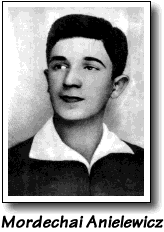Mordechai Anielewicz
Anielewicz  was born in 1919 into a poor family living in Warsaw. After finishing secondary school, Anielewicz soon joined the Zionist movement ha-Shomer ha-Tsa'ir, where he distinguished himself as an organizer and leader. In early 1940 he was a full time underground activist, setting up youth groups and underground newspapers. By mid-1941, Anielewicz began concentrating on transforming the underground youth movements into an armed resistance movement. He also began creating self-defense organizations in the ghetto.
was born in 1919 into a poor family living in Warsaw. After finishing secondary school, Anielewicz soon joined the Zionist movement ha-Shomer ha-Tsa'ir, where he distinguished himself as an organizer and leader. In early 1940 he was a full time underground activist, setting up youth groups and underground newspapers. By mid-1941, Anielewicz began concentrating on transforming the underground youth movements into an armed resistance movement. He also began creating self-defense organizations in the ghetto.
Anielewicz had been away from Warsaw during the summer of 1942. Upon returning, there were only 60,000 of the 350,000 Warsaw Jews remaining in the ghetto after the mass deportations. Anielewicz was determined to reinvigorate the Jewish Combat Organization (the Zydowska Organizacja Bojowa,or ZOB) and actively fight back against the Nazis.
After the mass deportations, there was far more support in the ghetto than ever before for armed resistance, and most existing underground groups joined the ZOB. Anielewicz was appointed commander of the ZOB in November 1942. By January, a small quantity of arms were obtained from the Polish side of the city.
On January 18, 1943, the Germans launched the second mass deportations from the Warsaw Ghetto. Caught by surprise, the ZOB staff did not have time to communicate. Different sections of the ghetto responded differently. Anielewicz commanded a major street battle. Some fighters deliberately joined the ranks of the deportees. On signal they attacked the German escorts while the rest of the Jews fled. Many of the Jewish resistance died, but Anielewicz survived.
Four days later the Germans halted the deportations. The ZOB knew that although they had temporarily stopped the deportations, there would be further confrontation. The ZOB prepared intensively for the next conflict.
On April 19, 1943, the final deportation of Jews was launched, which was the signal for the second phase of the Warsaw Ghetto Uprising. Initially the Jewish resistance fighters held the upper hand, and the Germans suffered losses. Street fighting continued for three days.
During the beginning of the uprising, Anielewicz was in the midst of the main fighting forces. When the street fighting ended and the Germans introduced a large military force against the few hundred Jewish fighters, he and some of his staff retreated into the bunker at 18 Mila Street. The Germans proceeded to burn down the ghetto, block by block. On May 8, 1943, Anielewicz and most of the main group of ZOB were killed in the bunker.
In a last letter to a friend, Anielewicz wrote on April 23, 1943:
Be well, my friend! Perhaps we will see one another again. The most important thing is that my life's dream has come true. Jewish self-defense in the ghetto has been realized. Jewish retaliation and resistance has become a fact. I have been witness to the magnificent heroic battle of the Jewish fighters.
Emmanuel Ringelblum, the Warsaw Ghetto archivist, wrote several biographical sketches of some of the leading personalities of the Warsaw Ghetto, including the following about Mordechai Aneilewicz:
Mordechai threw himself into the defense activity with all his zeal. Together with other groups and parties the Fighters' Organization was created, at whose head the coordinating commission of the political organization placed Comrade Mordechai. ...Mordechai was the soul of the organization, one of its most devoted workers.
A Teacher's Guide to the Holocaust
Produced by the Florida Center for Instructional Technology,
College of Education, University of South Florida © 1997-2013.